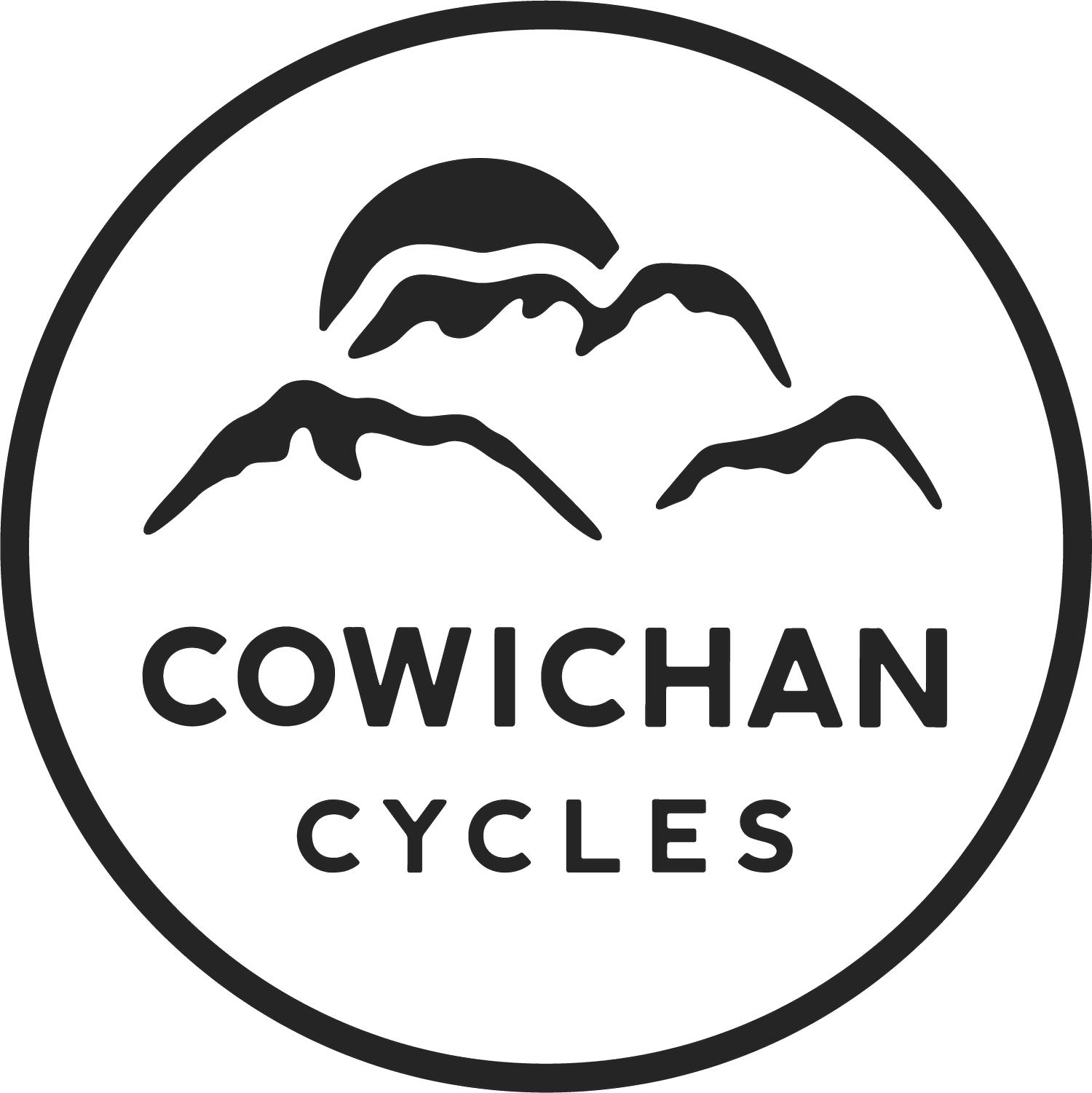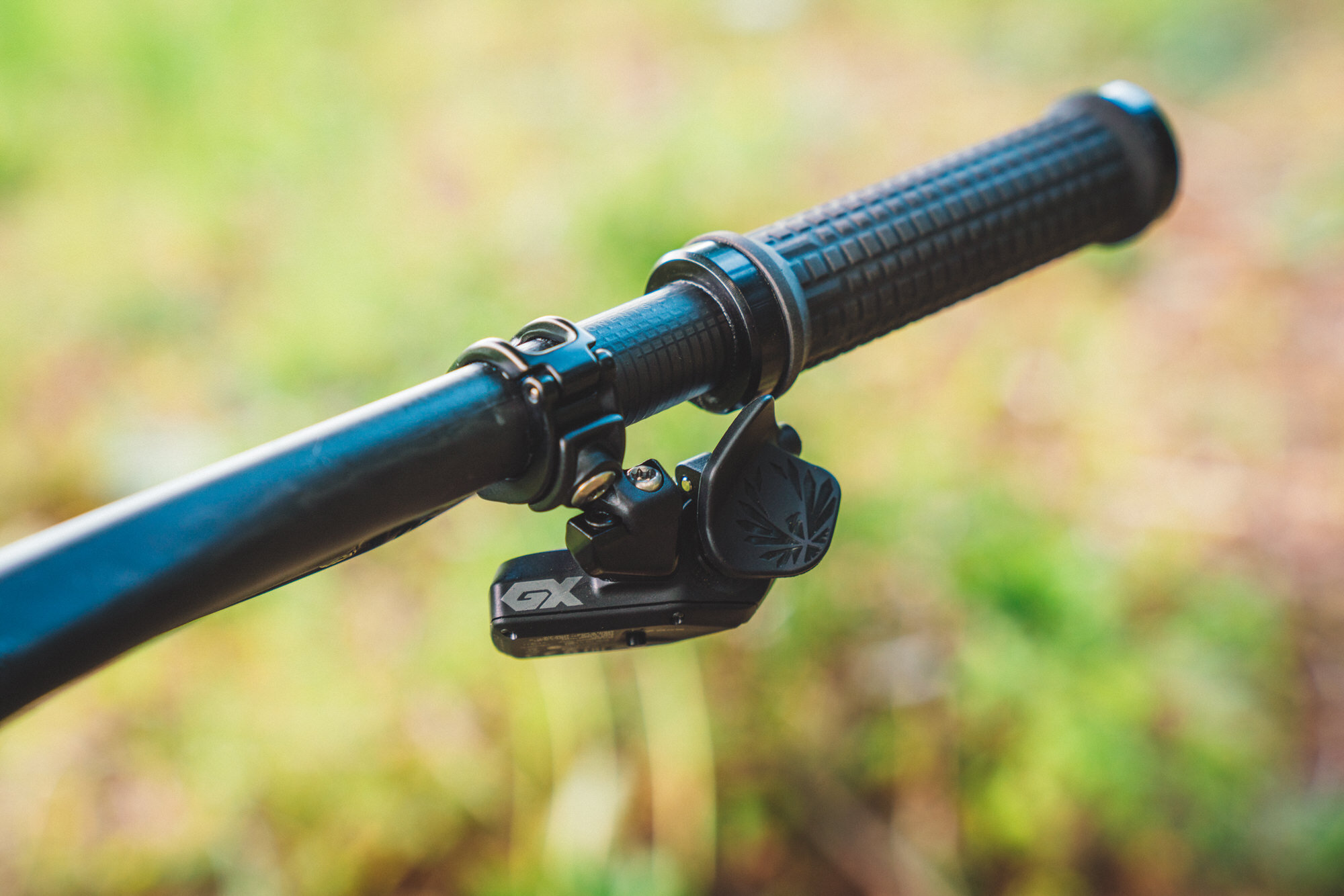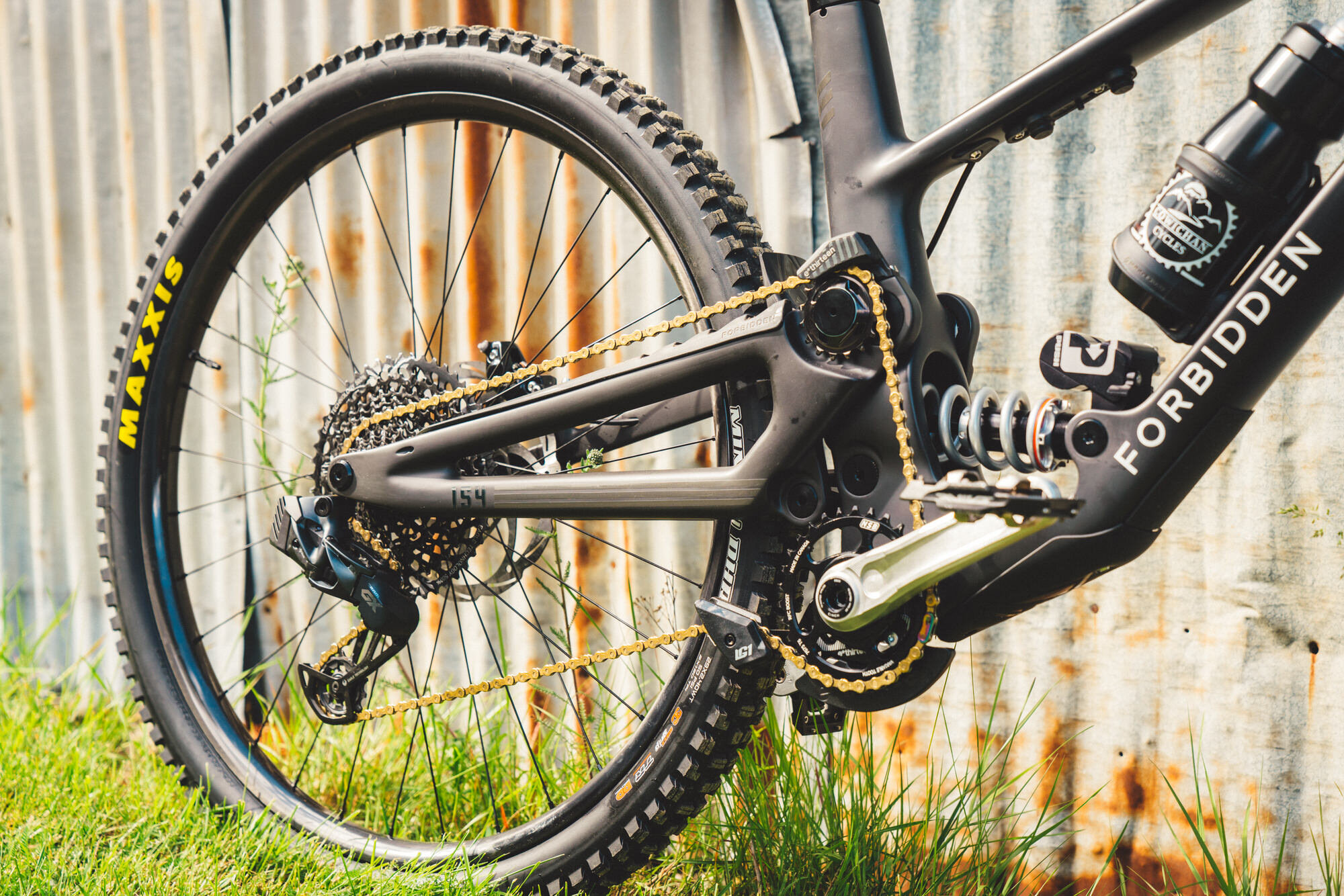Building Grant’s Forbidden Dreadnaught.
As a mountain bike nerd on Vancouver Island, it was impossible not to take note of Forbidden Bikes from the moment they launched in 2019. The wacky looking, high pivot, carbon fibre bike was sure striking, and the fact that the company was born just down the highway in Cumberland was very intriguing.
On a personal level, I wanted in, but on a business level we decided to play it safe and see if this little startup had what it took to make an impact in the market. We also wanted to be sure that the bikes would hold up over time. It turns out the reviews are still glowing and there hasn’t been any big ugly failures to scare us off. The timing was right and in December of 2020 we signed up as an official dealer.
Rider: Grant Lestock-Kay
Cowichan Cycles Relation: Owner
Build objective: To build out Forbidden’s new Dreadnaught into a formidable descending rig.
My time on Forbidden started out on the Druid, their inaugural bike. Although short(ish) in travel, and not overly aggressive in geometry, the Druid rode like a bigger bike than the numbers suggested. The rearward axle path and chainstay growth as the suspension compresses, absolutely makes the bike feel like it wants to go faster and find more bumps to gobble up. I had a ton of fun on this platform and it definitely wet my appetite for what a bigger version of this beast might do. When Forbidden dropped the Dreadnaught in the spring, my interest was piqued.
At launch we were able to grab two Dreadnaught frames for the floor. The medium sold almost immediately and its owner has been singing its praises since his first ride. The large frame, however, was hanging around a little too long for me to resist. Not only was my curiosity of the bike infectious, but the Push shock mounted to the rear has been high on my list of items to try for many years now. When the opportunity popped up to sell my trusty Druid, I wasted no time in building up the Dreadnaught. This build is less eccentric than my last but I made a point to snag some very exciting parts to keep the adventure alive.
Frame: Forbidden Dreadnaught, size large. So far this rig ticks all the boxes. The reach is roomy but not excessive, the head tube angle is proper slack, the seat tube angle is steep, and the wheelbase is long and ready for speed. Admittedly, this set up may be excessive for some of the more mellow riding I dabble in. Part of my reasoning for committing to a big rig is I have a hardtail build in the works (more on that later) which should carry the load nicely on less demanding trails. That means the Dreadnaught is free to live up to its full potential on the descents.
Shock: Push Elevensix. For those who don’t know, this shock is legendary. Custom made for both the rider and bike in their Colorado facility, Push offers custom suspension that most of us mortals without factory race team support can only dream of. This also happens to be my first coil experience on a trail bike. I don’t know whether to blame Forbidden or Push but the rear end of this bike tracks insanely well. I’m sold.
Fork: EXT ERA. Although less “legendary” than the Push Elevensix, the ERA has earned incredible praise in its relatively short time on the market. Every review I have read of this fork has been glowing to the point where it looked like reviewers were trying as hard as they could to avoid definitively calling it the best they have ridden. I love paying attention to what the media is reporting on new equipment. Sometimes things sound a little corny or over embellished and I occasionally disagree with certain statements, but I must acknowledge that many of our successful lines and products have been inspired by reviews. If enough publications report positively on a product, I typically try to source one for myself to see what all the fuss is about. If it lives up to my expectations, then we begin offering it to our customers.
This approach has started our relationships with many of our most successful lines/products including Ibis, 7idp, Onyx, and SQlab. Sometimes bike stores get caught in the routine of only selling what is convenient or mainstream, and although this approach is simple and low risk, it often leads to sterile product lines and more mediocre performance. I love this process of product exploration. It is one of the aspects of my job that keeps me engaged and hungry to improve. So far the ERA has been everything I had hoped for. It is insanely supple and offers great support later in the stroke. As long as it doesn’t have any reliability issues, you can expect to see this as a regular offering in store for those who are looking for the pinnacle of suspension performance.
Bars: Oneup carbon. I love that Oneup has taken an outside-the-box approach with these bars and designed a profile that is more than a boring aluminum remake. The oval profile theory is sound, with the bars offering extra vertical compliance while maintaining steering stiffness. They look good, are light, and offer a performance advantage over the competition.
Grips: Revgrips race series. I get bad arm pump and cramping in my hands on sustained descents which has led me to experimenting with somewhat unorthodox controls. I’m still relatively early days on the revgrips but I think we are getting along well. These grips sit on top of rubber bumpers that allow the grip to both flex down towards the bar as well as rotate slightly front and back. I hate the feeling of worn lock-on’s clicking back and forth, but these feel different. Although the movement is noticeable, it is dampened by the rubber and I don’t find it annoying. People often complain that they are pricey (which they are) but the non-adjustable race version that I’m running is a more reasonable $79, and the grip portion can be replaced once it has worn out for only $35. This means once you have forked out for the initial investment, changing out the wear portion of the grip is actually cheaper than many of the more standard offerings.
Stem: Farside Cyclic. For those who don’t know, I’m excited to share that I have started a component manufacturing brand with my business partner Emory Rempel. This deserves a separate blog post in itself, but the key takeaway is we are making premium bike parts here on the Island. I might be bias, but I think this is the hottest stem on the market. Very much looking forward to our upcoming official launch to the public. In the meantime, follow us on Instagram @farsidecomponents so you don’t miss the good stuff when we go live.
Brakes: SRAM Codes. I actually wanted to build this bike with my new favourite brakes, the Hayes Dominions, but they were unavailable in this COVID parts shortage. Jumping back on Codes was a good reminder that I’m not exactly settling by moving back to SRAM’s DH stoppers. Less cool and exotic, but this is a damn fine brake set. Lots of power and adjustment aplenty; Codes will always be old faithful.
Rotors and adapters: Formula. I snagged these rotors and adapters because they were one of the first options that I could find coming in at 220mm. I rarely outride proper DH brakes and these are absolutely excessive for me, but they are super cool and it’s the trendy new thing to go super big up front. 220/200mm and I can dump speed like nobody’s business.
Seatpost: BikeYoke Revive. I first grabbed a bike yoke for a personal build years ago and absolutely loved it. We have since seen many come stock on Ibis bikes and they have proven to be reliable as well as feeling fantastic. The lever is solid, the action is smooth, and the ability to deal with any post sag in a matter of seconds with the Revive lever is a huge plus. We still sell more Oneup posts due to their incredible value, but for riders looking for the best on the market, BikeYoke is hard to beat.
Saddle: SQlabs 60X. I first noticed SQlabs when lurking around various NSMB articles where they were praised like god’s gift to seats. Eventually I tried one for myself and I was sold. They now find their way on to each of my bikes and have been a slam dunk for us in store. They are not cheap but we have had a 100% success rate with these saddles. If you just can’t quite find a seat that makes your butt at home, maybe there is a Sqlab model in your future.
Drivetrain: SRAM GX AXS. Now I really don’t get along with electronics. They have always been a weak point of mine and I despise trying to keep things charged. I think this is why I have managed to avoid SRAM’s wireless shifting for so long. When they finally launched GX AXS, the price was low enough that my curiosity got the better of me and I decided to take the plunge…I love it. It’s excessive, expensive, and lovely. It turns out I love perfect instant shifts every time more than I hate charging batteries. I think there is going to be more AXS in my future.
Cranks: Raceface Atlas. Ok my cranks got weird. I wanted to go with 165mm length as I truly don’t notice a change in efficiency with the shorter length, but the reduction in pedal strikes is a huge benefit. Unfortunately, the parts shortage left me with little options, and the Raceface Atlas cranks made the most sense. I’m not a huge fan of 30mm spindles as they provide less room for bearings in 73mm BB’s. I do understand the claims of increased stiffness but it’s not a benefit I feel I get much out of. Regardless, I don’t plan on running these for too long as there is more experimenting to do here soon… My cranks came in a bright orange and spacing for an 83mm bb, neither of which worked for my application. A quick bath and a light scrub in some lye (don’t try this at home) stripped them down to the subtle raw aluminum that went better with my build. The spacing got goofy with some extra BB spacers and a ton of spacers on the spindle to bump out the cranks. Not something I would offer as an official job through the shop, but something weird I don’t mind trying on myself.
Wheels: We Are One Union rims on Industry Nine 1/1 hubs. We Are One makes up for their cumbersome name with a beautifully made product that is manufactured here in B.C. This is a huge achievement being able to produce quality carbon that is economical in a domestic setting with higher wages and a healthy environment. Hat’s off to those folks. I don’t typically notice a ton in wheel ride quality on my personal bikes, but I can be tough on rims so the lifetime warranty had strong appeal here. No complaints on my early rides. Provided they hold up, I will be a happy camper. Industry Nine’s Hydra and 1/1 hubs use a creative engagement mechanism that allows the hub to engage additional backup pawls that are on standby as the hub flexes. This ultimately means that when flexed, the hub grabs on more rather than loosening up like a traditional pawled system. So far we have seen good success with this system and it seems to be living up to its bold claims. The 1/1 hubs have slightly reduced engagement when compared to the impressive Hydra’s, and they only come in black. Both were not deal-breakers for me and I have been pleased with them so far on this build.
Tires: Minion DHR/Assegai. I love experimenting with most new products but I admittedly have a harder time when it comes to tires. This combo has been my go-to for some time now, and it is just so dependable that I have a hard time letting go. Always dependable, the DHR/Assegai combo lands itself on another build.
The ride:
Now it’s still early days, but this bike absolutely rips. I can’t recall ever feeling this composed at speed and in chunder. This does admittedly come with a slight loss in agility but dang, this bike is fast. The coil suspension in the rear is so sensitive and pairs very well with Forbidden’s suspension platform. These high pivot bikes do tend to have a little suspension feedback under braking but it’s not something that I’m picking much up on, and the benefits when riding wide open seem to outweigh any disadvantages. It’s been years since I’ve ridden a DH bike and this machine is definitely stirring up some memories. I just need to keep reminding myself that I’m not invincible when I start charging on this thing.
The flip side to this great descending is that climbing feels like a bit more of a chore. My build is heavy; you can feel the idler if you pay attention and it doesn’t have that lively “climb’s like a goat” quality when trying to hop up ledges and over roots. However, considering the bike’s intentions, it is still very respectable. The peddling platform is efficient, the seated position is good, and it can get you up to the top just fine. I think most of my complaints come from the fact that I’ve spent the majority of my time over the last few years on short travel bikes and I am still getting accustomed to the big rig. Compared to other bikes in a similar category, the Dreadnaught holds its own, and with a slightly less DH focused build, it would only improve.
I’m very pleased to be building our relationship with Forbidden. We are continually focussing in on the mountain bike side of the market, and joining a local premium brand like Forbidden only makes sense. The Druid was a great platform that will be a strong option for many of our customers, but when applying that platform to a longer travel bike, I think the magic of the formula starts to really shine. Still early days on this beast, but the bar is set high.
Photos: @robwilson.photography
















